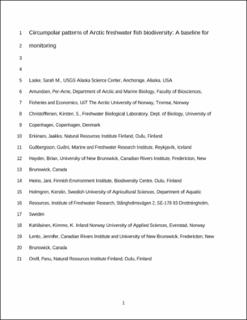| dc.description.abstract | Climate change, biological invasions, and anthropogenic disturbance pose a threat to the biodiversity and function of Arctic freshwater ecosystems. Understanding potential changes in fish species distribution and richness is necessary, given the great importance of fish to the function of freshwater ecosystems and as a resource to humans. However, information gaps limit large‐scale studies and our ability to determine patterns and trends in space and time. This study takes the first step in determining circumpolar patterns of fish species richness and composition, which provides a baseline to improve both monitoring and conservation of Arctic freshwater biodiversity.
Information on species presence/absence was gathered from the Circumpolar Biodiversity Monitoring Program's Freshwater Database and used to examine patterns of freshwater fish γ‐, α‐, and β‐diversity across 234° of longitude in the Arctic. The metrics of diversity provided information on species richness and composition across hydrobasins, ecoregions, and Arctic zones.
Circumpolar patterns of fish species biodiversity varied with latitude, isolation, and coarse ecoregion characteristics; patterns were consistent with historic and contemporary barriers to colonisation and environmental characteristics. Gamma‐diversity was lower in the high Arctic compared to lower latitude zones, but α‐diversity did not decrease with increasing latitude below 71°N, reflecting glacial history. Alpha‐diversity was reduced to a single species, Arctic charr Salvelinus alpinus, in ecoregions above 71°N, where γ‐diversity was the lowest. Beta‐diversity indicated little variation in the composition and richness of species across the High Arctic; at lower latitudes, ecoregions contained more species, although species composition turned over across large spatial extents.
In an analysis of five ecoregions in the circumpolar Arctic, physical isolation, and ecoregion area and topography were identified as strong drivers of γ‐, α‐, and β‐diversity. Physical isolation reduced the γ‐ and α‐diversity, and changes in β‐diversity between adjacent locations were due mainly to losses in species richness, rather than due to differences in species composition. Heterogeneity of habitats, environmental gradients, and geographic distance probably contributed to patterns of fish dissimilarity within and across ecoregions.
This study presents the first analysis of large‐scale patterns of freshwater fish biodiversity in the circumpolar Arctic. However, information gaps in space, time, and among taxonomic groups remain. Future inclusion of extensive archive and new data will allow future studies to test for changes and drivers of the observed patterns of biodiversity. This is important given the potential impacts of ongoing and accelerating climate change, land use, and biotic exchange on Arctic fish biodiversity. | en_US |
